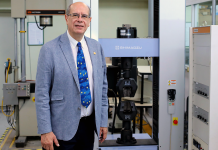
This article will review refractory ceramic fibers (RCFs), which are amorphous, inorganic, man-made aluminosilicate fibers. RCFs belong to a class of materials termed man-made vitreous fibers, which includes glass wool, rock (stone) wool, slag wool, mineral wool, and special-purpose glass fibers.
The products made from RCF wools are most important for thermal-processing installations and industrial furnace construction and insulation. The RCF products are lightweight and easy to handle, with high temperature capabilities, good thermal shock and chemical resistance, and low thermal conductivity and heat loss. They are generally used in commercial applications requiring lightweight insulation that is capable of withstanding high temperatures, such as furnace and kiln insulation, fire protection, and automotive exhaust systems.
RCF products are used in high-temperature applications in many industries including metals processing, heat treating, glass and ceramics, chemical and petrochemical, automotive, aerospace, power generation, and even domestic appliances.
The maximum service temperature of different RCFs varies in different atmospheres. Complete replacement of dense refractories with an RCF product form provides the most savings in this regard. Using RCF as backup insulation or as a hot-face veneer over an existing refractory lining, however, affords significant energy savings as well.
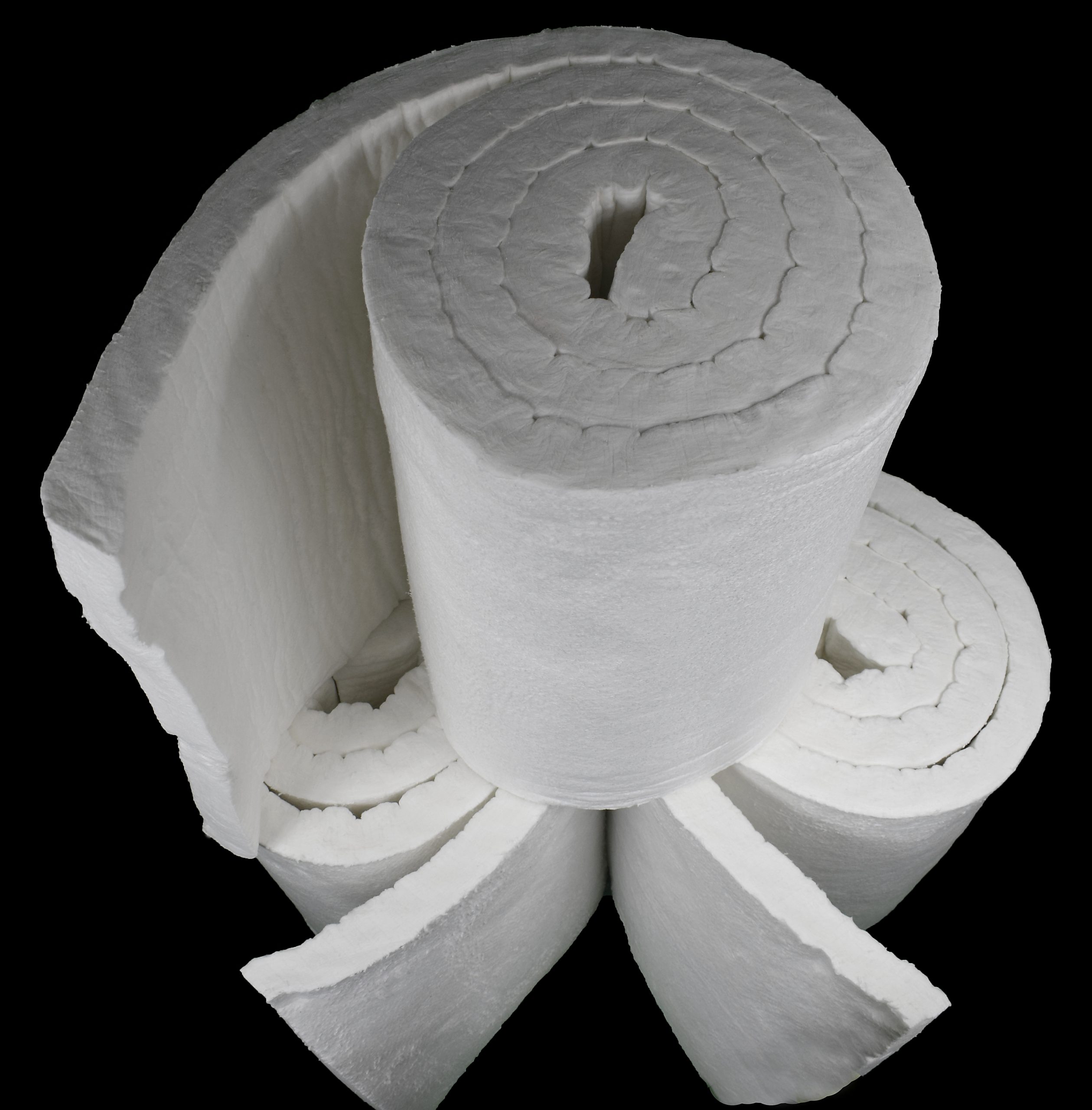
Various types of RCFs
Refractory ceramic fibers are synthetic fibers produced by the melting and blowing or spinning of calcined kaolin clay or a combination of alumina (Al2O3), silicon dioxide (SiO2), or other oxides, usually in a 50:50 weight ratio. The most common grade RCF fiber provided by most USA-based fabricators and suppliers is the “high purity” grade having a temperature rating of around 1,260°C max or 1,180°C continuous use.
There is a higher temperature grade RCF containing about 15 percent ZrO2 with improved temperature rating of about 1,427°C max or about 1,343°C continuous use for the most common zirconia grades. Pricing for this grade is a bit higher than the standard high purity grade.
A biosoluble RCF grade is called AES wool (alkaline earth silicate), consisting of amorphous fibers produced by melting a combination of CaO, MgO, and SiO2. AES fiber products having a temperature rating of around 1,260°C max or 1,150°C continuous use, not quite as high as the standard high purity RCF. The calcium and magnesium oxide content are easier for the body and lungs to dissolve, so called biosoluble.
Products made of AES exhibit lower chemical resistance and are more prone to recrystallization, thereby limiting their potential application in thermal-process engineering. The main application for these AES materials is in the domestic appliance industry and in industrial processes for temperatures to a maximum of 1,100°C, although rated for 1,150°C continuous.
Polycrystalline wools (PCWs) are a higher temperature RCF, consisting of fibers with an Al2O3 content above 63 wt. percent and a SiO2 content under 37 wt. percent. Most suppliers produce the PCWs fiber by aqueous spinning solutions in the sol-gel method. The sol-gel-derived green fibers formed initially as a precursor are then crystallized by means of heat treatment and then handled much like standard RCF and AES fibers. Polycrystalline fiber wools have a max temperature rating of around 1,800°C max and 1,650°C continuous use. (Table 1)
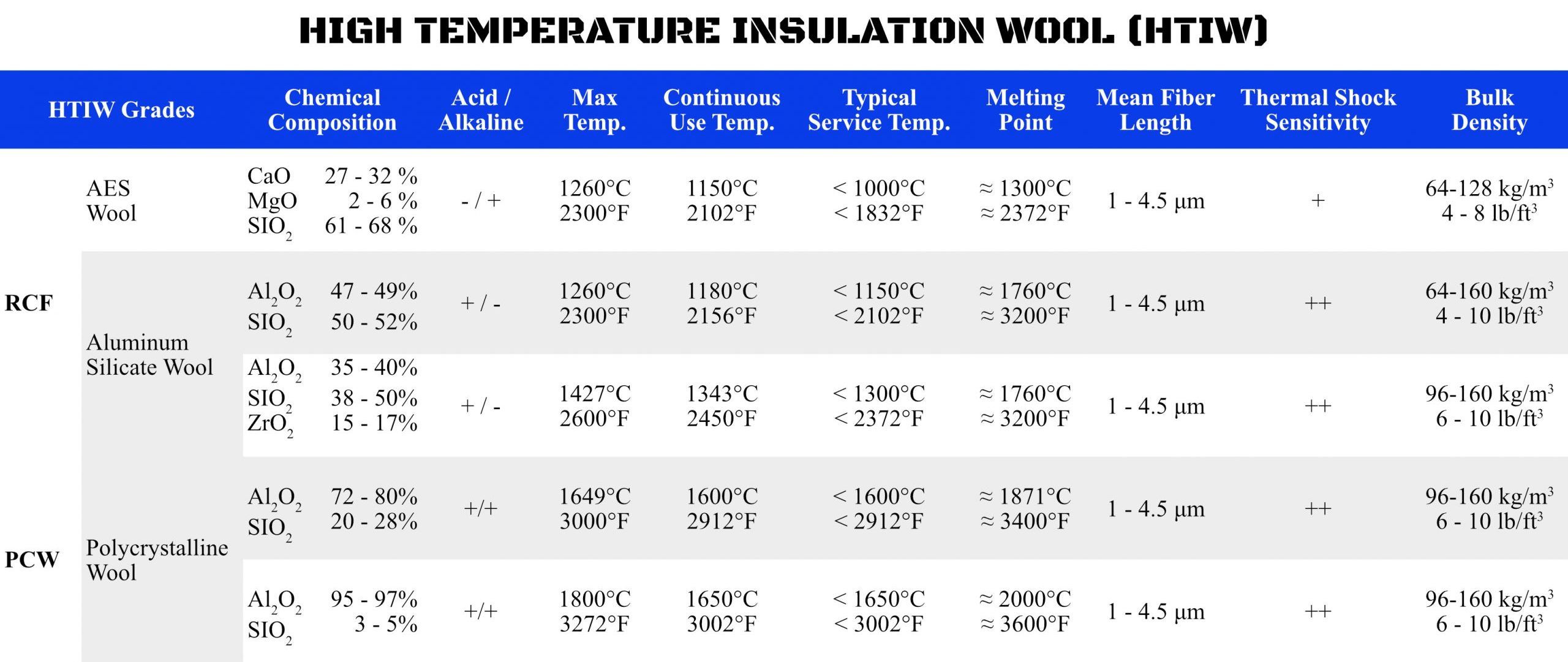
Note that the actual maximum continuous use temperatures for RCF fibers are generally at least 150-200°C (safety allowance) below the max use or classification temperature. This is because, in contrast to the determination of the classification temperature in ideal, neutral-firing conditions with a relatively short exposure (24 hours), the products used in the field are not only exposed to high temperatures but to additional chemical and physical stresses that often deviate far from ideal conditions and therefore limit the application temperature. (Figure 1)
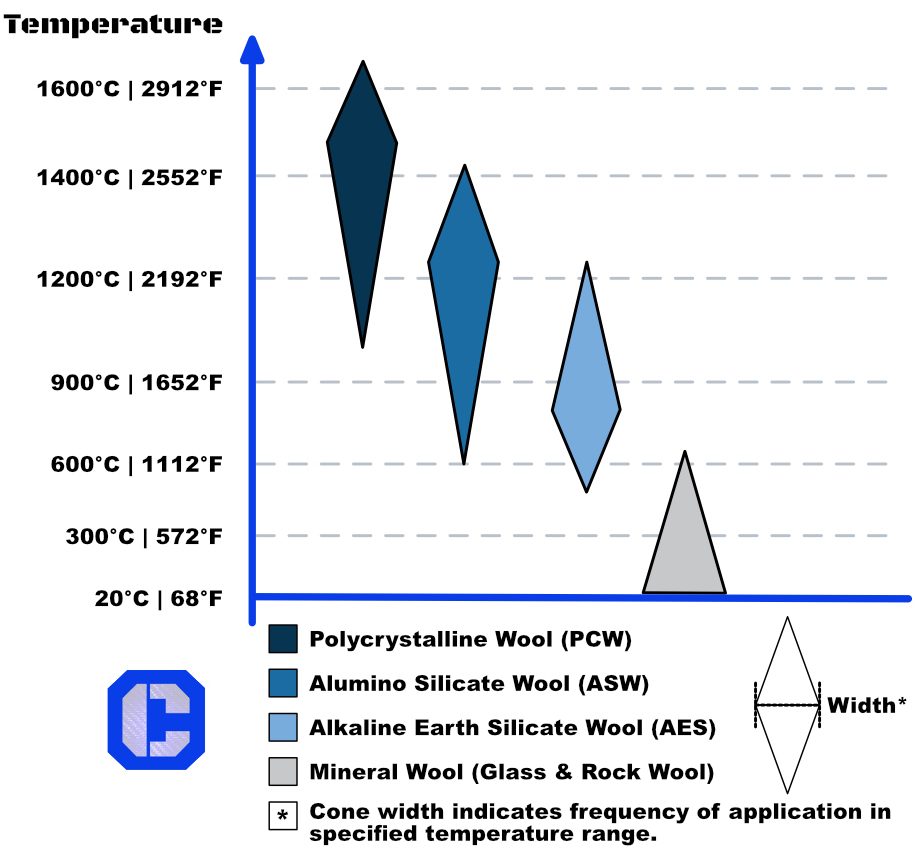
The bulk RCF wool previously described can be used directly for some applications, but are more commonly converted into other physical forms, including blankets, modules, paper, board, vacuum-formed parts, textiles, foam and putties, or pastes, adhesives and coatings. Conversion to various physical forms takes place at locations where RCF fibers are produced, as well as at facilities operated by converters (producers of intermediate goods) or end users. (Figure 2)
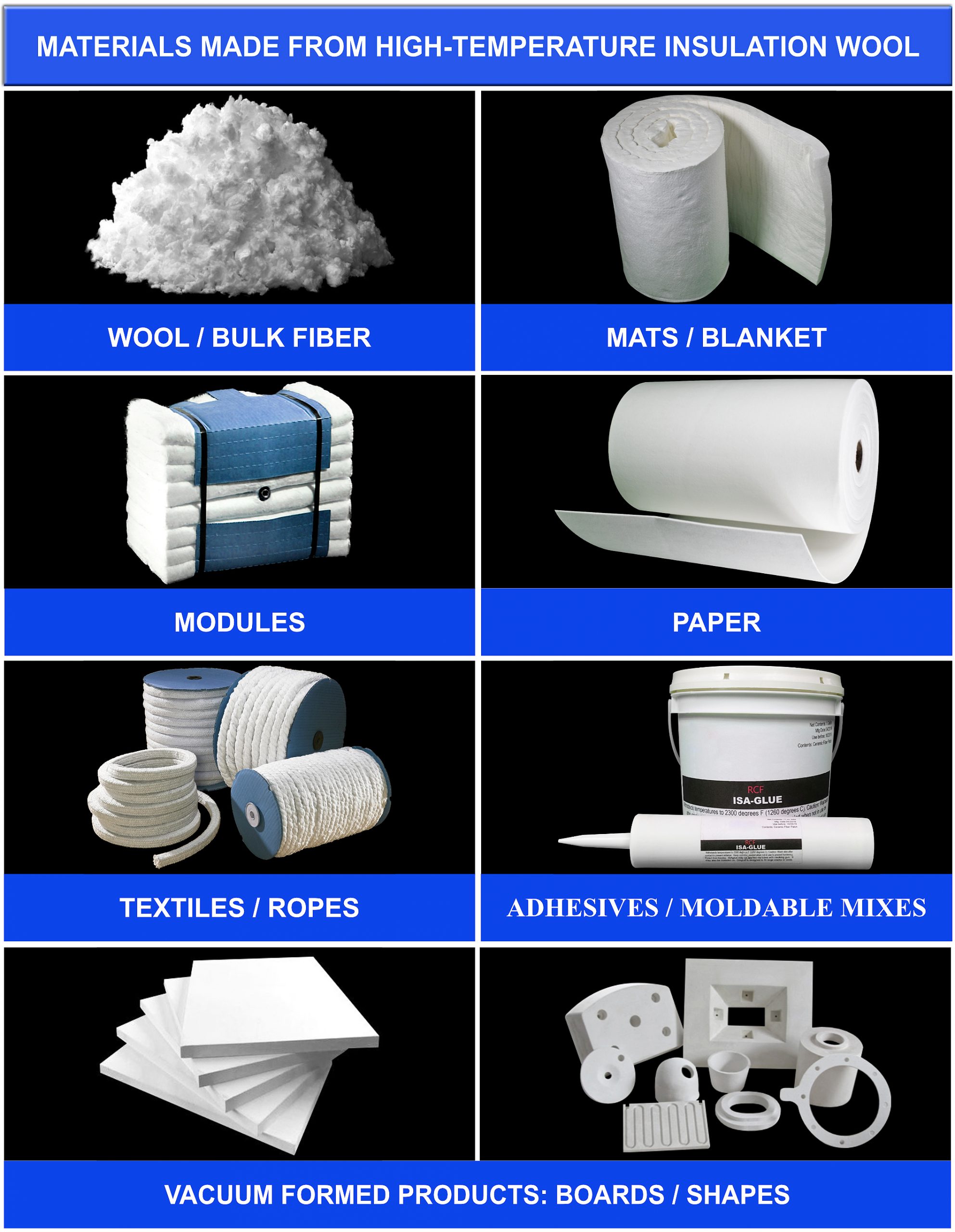
Ceramic blankets
RCF blankets are manufactured by a felting process from a water-based slurry of the RCF fibers with needling from both sides to help interlock the fibers and felt layers, dried in continuous ovens, which results in high-porosity binder-free porous blankets with flexibility and good handling strength. Blankets are produced in varying dimensions, thicknesses, densities, and temperature ratings based on the RCF fiber used. For the standard RCF and AEW fibers, blankets are offered in four, six, and eight pound (per cubic foot) densities, widths of 12, 24, and 48 inches, and thicknesses from 1/8 to two inches. Alternate sizes and shapes are often special orders with capabilities up to 60 inches wide.
RCF blanket Wet Wool is a unique product that takes the standard RCF binder-free blanket and pre-wets it with water-based inorganic bonding agents and then packages it in a clear polyethylene bag to retain the wet binder during shipping and storage. The manufacturing process results in flexible insulation that can be formed to complex shapes in place and air dries to form a hard, rigid structure. Additionally, the material can be cured by immediate exposure to temperature in application. Material has a dry density of 12-18 lbs/ft3.
Foil-backed or wrapped RCF blanket is also commercially popular, with the foil improving abrasion and moisture resistance, and reducing loose fiber loss. The foiled blanket is often used in appliances, automotive applications, chimney repair, and gasket seal applications.
Modules
RCF modules are created from folded and compressed blanket, banded to standard block shapes and sizes, with metallic attachment mechanisms folded into the shape. These modules are then used as building blocks to line furnaces and kilns. The assemblies of the modules are designed to create a no-gap environment upon unbinding, where the modules spring apart laterally, sealing gaps and holding in place. Ceramic fiber module systems provide an energy-efficient solution that can aid in alleviating the need for controlled start-up after installation. Common uses include annealing and tempering furnaces, combustion chambers, oxidizers, burn-off ovens, hydrocarbon reformers, kilns, incinerators, ducts and flues, and more.
Ceramic paper
Ceramic fiber paper is manufactured through a fiber washing process which produces a non-woven matrix blend of the fibers, water-based organic binders (∼10 percent), and additives to form randomly oriented fiber continuous mat that is flexible and uniform. This process controls the content of unfiberized glass to a minimal level within the paper. Ceramic paper is typically available in RCF and PCW grades in rolls that are 24 and 48 inches wide, with customized sizes up to 60 inches wide. Note that the high binder content results in smoke during initial heat up, resulting in a very weak powdery product after firing.
Binderless paper is available at a premium price which provides a smoke-free option and is manufactured without the organic binder system.
Vacuum Formed Products
RCF porous rigid boards are manufactured through a vacuum casting process using a slurry made of RCF fibers with inorganic and organic binders, formed to near thickness, dried in an oven, and sanded to final thickness. Standard casting thickness can be up to six inches, but thicker than four inches is often made by stacking board assemblies. Boards are fabricated in low and higher densities to standard sizes, but also available up to 60 inches diameter. Low density boards are slightly better insulators, but they are not as durable and strong as high density.
Customized shapes can be fabricated with made-to-order vacuum molds or by assemblies of smaller parts and layers bonded with RCF cement. The rigid RCF molding mix is machinable and can be manufactured in a wide range of shapes and sizes to meet customer needs, including bolt-together pipes, manifolds, elbows, transitions, and custom fittings, as well as burner blocks, peep-sight windows, and sleeves for any unique furnace system design. It also is possible to embed heating elements in the hot face of the insulation and attachment mechanisms into the body and back of the boards.
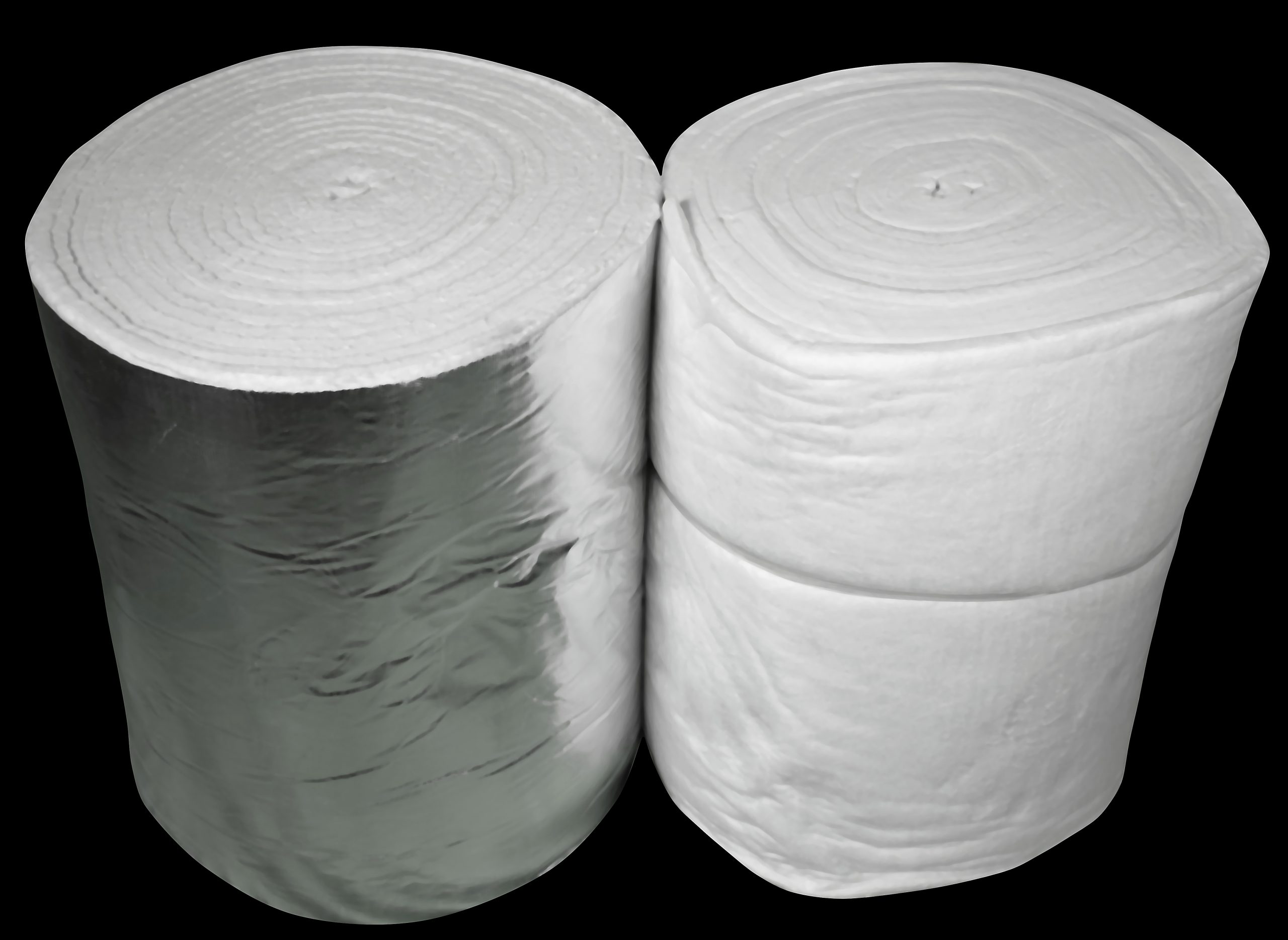
Moldable mixes and adhesives
There are various RCF ceramic moldable mixes consisting of RCF fibers dispersed in a slightly sticky refractory binder system to permit vibratory or hand-packed casting. The putty-like consistency allows easy application by caulking, troweling, hand-forming, and pressure molding. Once cast in place, the moldable mix dries and hardens with minimal shrinkage yielding high porosity, rigidity, high strength, and machinability.
Fiberboard glue is a colloidal silica- and alumina-based RCF mix best used for joining two pieces of ceramic fiber board together or patching small areas. The glue is manufactured by dispersing ceramic fibers in a liquid-based refractory binder system. The resulting viscous consistency allows the glue to be easily applied to refractory ceramic fiber surfaces by troweling or hand forming. Once fully dried, the glue can be sanded or cut using traditional finishing methods due to the product’s excellent mechanical strength. Additional coats can be applied or used as a coating on fiberboard shapes, available to match all RCF temperature ranges.
Textiles and rope
Textile products are manufactured from RCF and PCW fiber with the same temperature ratings. For improved manufacturing and handling, most textile products do contain approximately 15 percent organic carriers, which will smoke during burn out. Textile products can also contain reinforcement insert materials of Inconel wire or continuous fiberglass filament to increase handling strength during installation and to enhance fiber durability. Inconel reinforcement has a temperature rating of 2,000°F (1,093°C) and fiberglass reinforcement has a temperature rating of 1,200°F (649°C), so while the fiber can handle higher temperatures, the reinforcement may give out sooner.
RCF cloth, tape, and sleeving are very strong and flexible fabrics as formed. Insert materials of Inconel wire and fiberglass filaments are incorporated into the yarn to increase the tensile strength of the fabrics both before and after exposure to heat. Typical applications include gaskets, seals, pipe wrapping, furnace, and welding curtains. A variety of sizes, diameters, and rolls are available off the shelf.
Round and square RCF braid are manufactured by over-braiding around a core of ceramic fiber to achieve maximum resistance to mechanical abuse. In addition to its superior strength, round and square braids also exhibit minimal unraveling when cut.
Three-ply twisted ceramic fiber rope is manufactured by forming strands of thick RCF yarn, which are then twisted into a three-ply rope.
Both the braid and ropes are readily available in diameters from 1/8 to 2 inches and are used as gaskets and seals in furnaces and reinforcements for larger RFC forms.
Tadpole gaskets are custom manufactured to customer specifications from sewn blends of RCF fabric, blanket, rope and tape. Available in many designs such as single or double bulbs or single or double tails, these gaskets provide an excellent solution for high-temperature sealing applications such as door, flange, and air-handling valve gaskets.
Ceramic fiber products have lightweight, good heat insulation performance and thermal stability, good chemical stability, easy processing, and convenient construction. Its defect is that it is not abrasion and impact resistance, which cannot resist high speed air flow scouring, and the erosion of slag. There are various ceramic coating materials and rigidizer (colloidal silica and alumina) available to reduce the thermal shrinkage and increase the mechanical strength of the RCF parts.
Conclusion
Refractory ceramic fibers are used in commercial applications requiring lightweight insulation that is capable of withstanding high temperatures, such as furnace and kiln insulation, fire protection, and automotive exhaust systems. The RCF fibers are formed into lightweight and easy-to-handle high-temperature insulation products with excellent thermal shock, chemical resistance, low thermal conductivity, and heat loss and low weight.
These products include bulk fiber, blankets, modules, paper, board, vacuum formed parts, textiles, foam, putties, adhesives, and coatings. The RCF products are used in high-temperature applications in many industries including metals processing, heat treating, glass and ceramics, chemical and petrochemical, automotive, aerospace, power generation, and even domestic appliances.
Complete replacement of dense refractories with an RCF product provides cost savings in fuel needs and efficiency. Even using RCF as backup insulation or as a hot-face veneer over an existing refractory lining results in significant energy savings as well.


